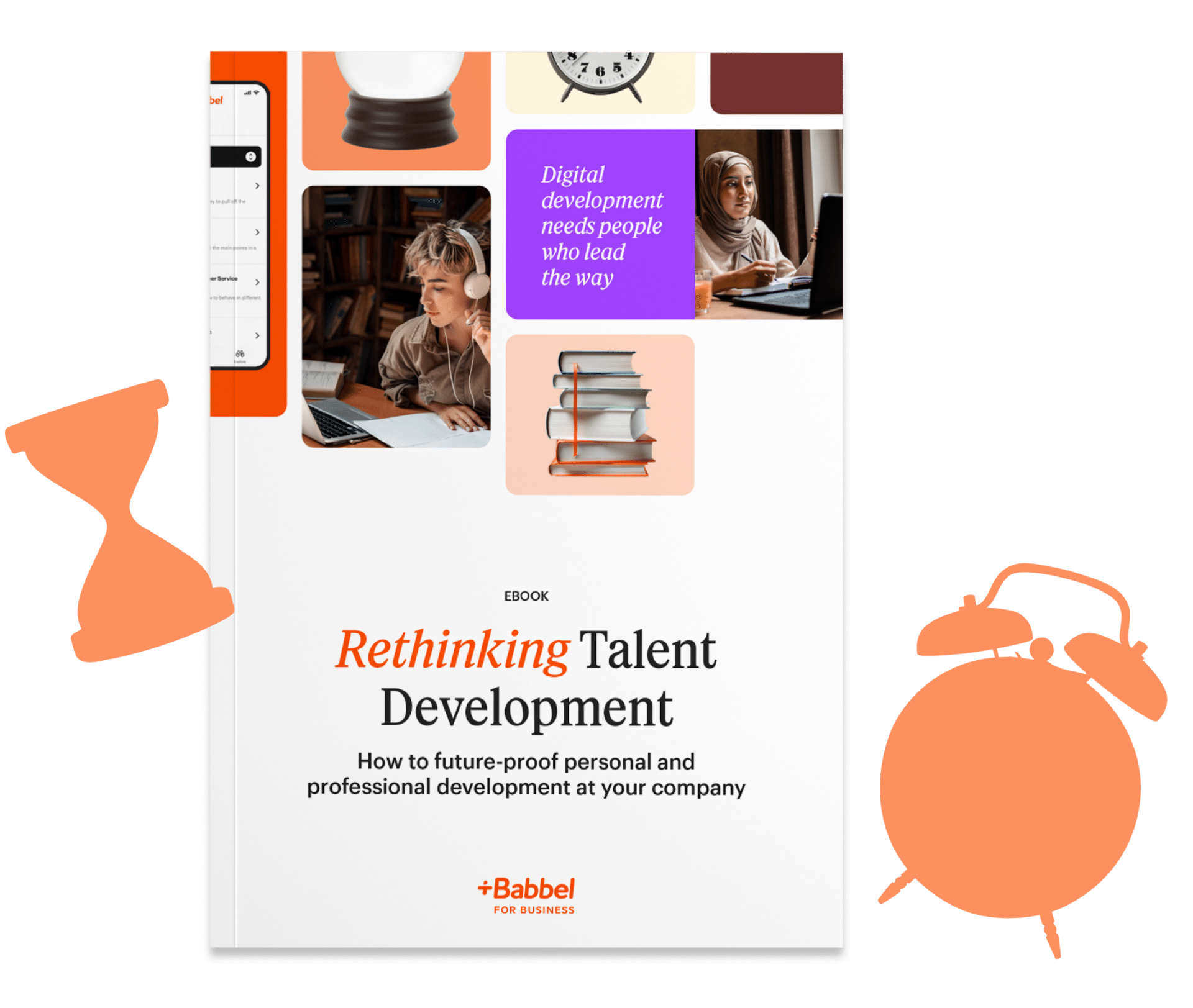In this post, we explain what talent development is, why it’s important, and the benefits it will bring to your company. We also share a free, actionable workbook you can use to build your own talent development strategy.
Talent development is crucial for business success. Not only does it improve company culture and boost employee retention, it’s also one of the most effective and sustainable tools for addressing skills gaps.
In the age of talent shortages and rapid digitalization, it’s important to nurture your employees’ skills and help them reach their full potential. If you’re not already on board with talent development, now is the time — and we’ve put together this guide (and a free downloadable eBook) to help you.
Table of Contents
- What exactly is talent development?
- Why does talent development matter?
- What are some examples of talent development?
- How to master talent development with our free, practical eBook
- Talent development in 2023: The takeaway
Whatever your current status, our free talent development eBook will help you evaluate, rethink, and ultimately master talent development at your organization. Download it now and get started today.

How to attract and retain talent?
To survive in today’s competitive recruitment market, companies must have a compelling Employer Value Proposition (EVP) that attracts and retains staff by understanding their needs. In this eBook, we’ll help you take a fresh look at your EVP, so you can meet the needs and expectations of job seekers, and retain talent across your business.
What exactly is talent development?
Talent development is anything a company does to foster employee learning and growth. It aligns individual learning goals with the needs of the organization — making sure that both the business and its employees can succeed.
A company’s overall talent development efforts are made up of many different parts. It can comprise processes, tools, events, and people (think dedicated talent development professionals within the organization). Talent development is also a strategy, a mindset, and a company culture.
We’ll explore some concrete examples of talent development a little later on. For now, let’s consider why it’s important.
Why does talent development matter?
Talent development is critical for business success. It’s important in the current world of work because it:
- Improves company culture
- Boosts employee retention
- Sustainably tackles skills gaps
Let’s dive deeper into the benefits of talent development.
Talent development improves company culture
According to LinkedIn research, 59% of employees identified “professional development opportunities” as the top area employers should invest in if they want to improve company culture — placing it above flexible work support and mental well-being.
But what’s the link between talent development and company culture?
First, employees who have access to learning and development opportunities are 15% more engaged. Second, when you invest in talent development, you give your employees concrete goals and expectations to work towards. This provides clarity in their role and nurtures a culture of transparency and trust.
All of these factors — employee engagement, transparency, and trust — are the cornerstones of a positive company culture.
Talent development helps to attract and retain employees
The war for talent, the Great Resignation, quiet quitting, the Great Reshuffle… not just buzzwords, but real challenges for employers. It’s vital to attract and retain employees — and talent development helps you do so.
In a 2022 report by the Achievers Workforce Institute, jobseekers cited “identifying opportunities for promotion and growth” as the top reason they planned to look for a new job. At the same time, a LinkedIn study found that 94% of employees are more likely to stay with companies that invest in their learning and development.
Invest in talent development and you’ll set yourself apart as an attractive employer.
Learn more about the newest learning and development trends here.
Talent development is crucial for addressing skills gaps
87% of companies report that they have skills gaps internally — or that they expect to in the near future (McKinsey & Company). And it comes at a hefty price, with PwC estimating that the skills gap in the US will result in a loss of $8.5 trillion by 2030.
The skills gap is two-fold. Employers are noticing a major digital skills gap, driven by rapid technological advancements and digitalization. There’s also a significant soft skills gap emerging.
With Deloitte Access Economics predicting that, by 2030, soft-skill-intensive occupations will make up two-thirds of all jobs, soft skills are more important than ever in the modern workplace — as such, closing the soft skills gap is an urgent priority.
Talent development offers a sustainable approach to addressing these skills gaps, promoting internal mobility, and ensuring your employees are equipped for success.
Curious about Babbel for Business?
Book a demo now and let us show you how our platform can transform your business.
Better company culture, a boost to employee retention, and a long-term solution to critical skills gaps — that’s a compelling case for talent development all around.
So what does talent development actually look like in action? Let’s explore some instances in more detail in the next section.

What are some examples of talent development?
At the strategic level, talent development is the ongoing process of setting business goals and identifying what skills and expertise are needed to achieve them. Part of this filters down into helping individual employees define their learning goals and map out their professional development pathways.
Talent development also involves setting up learning and training programs, providing access to relevant courses, tools, and learning opportunities, and defining how progress will be measured.
Another example of talent development is mentorship and coaching — be it formally through an official mentorship program, or informally in day-to-day interactions and peer-to-peer learning.
Besides the act of learning itself, talent development is both a mindset and a company culture. It fosters continuous and lifelong learning, empowering employees to grow and prioritizing internal mobility.
All of the following are examples of talent development in action:
- Hiring a dedicated talent development expert to coordinate the company’s talent development efforts.
- Any kind of learning, upskilling, or training opportunity — including online courses, mobile learning, microlearning, workshops, and webinars.
- Mentorship programs and informal coaching.
- Working with employees to set professional development goals.
- Putting employees forward for internal job changes and/or promotions.
- Actively recruiting ‘lifelong learners’ when hiring new candidates.
How to master talent development with our free, practical eBook
We’ve seen how necessary talent development is, especially in the current context of ever-widening skills gaps and the ongoing challenge of employee retention.
But you’re probably now wondering…How can I master talent development within my own organization?
Building an effective talent development strategy is no simple task — but it can be broken down into small, manageable steps that will add up to significant and sustainable progress over time.
To help you get started, we’ve created a free talent development eBook:
This guide will walk you through the process of rethinking and improving your talent development efforts, broken down into the following steps:
- Make a candid assessment of your company’s current position when it comes to talent development. Use our free checklist to evaluate attitudes towards talent development in your company, as well as the current skills, tools, and methods available.
- Create a vision of the future. Write out your answers to three key questions. These will lead you to a clear and detailed vision for how talent development should look in your company.
- Find companions and allies to support your vision. We’ve included three practical ways you can go about finding, winning, and uniting allies — people who will share your talent development goals and help you move towards them.
- Decide how you’ll approach talent development in your company. There are two distinct pathways you can take when it comes to rethinking talent development in your organization. We explain them both, weigh up the pros and cons of each, and help you decide which approach is best for you.
- Follow your chosen pathway without compromising. This can be one of the trickiest parts of talent development — rethinking and digitalizing your efforts without diminishing quality. We outline 3 pillars to pay attention to and ensure you’re not making any compromises.
- Get rid of the old to make room for the new. This final step is all about action. You’ll use our prioritization matrix to figure out what projects and initiatives your company needs to be ready for the future — and which ones you can put on the back-burner.
We’ve designed our eBook to be both informative and practical. By the end, you’ll have a clear understanding of where your company currently stands with talent development, where it needs to be headed in the future, and — most importantly — how to get there.
Talent development in 2023: The takeaway
Talent development is essential for companies that want to increase their culture and employee retention. If you already have a talent development strategy in place, you’ll want to ensure that it’s relevant for the modern workplace.

How to attract and retain talent?
To survive in today’s competitive recruitment market, companies must have a compelling Employer Value Proposition (EVP) that attracts and retains staff by understanding their needs. In this eBook, we’ll help you take a fresh look at your EVP, so you can meet the needs and expectations of job seekers, and retain talent across your business.







